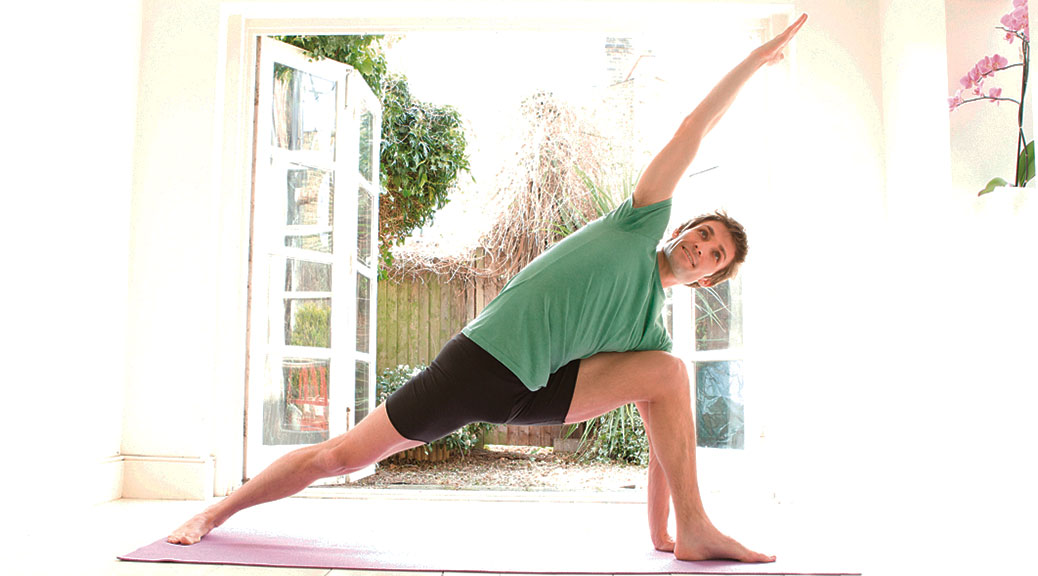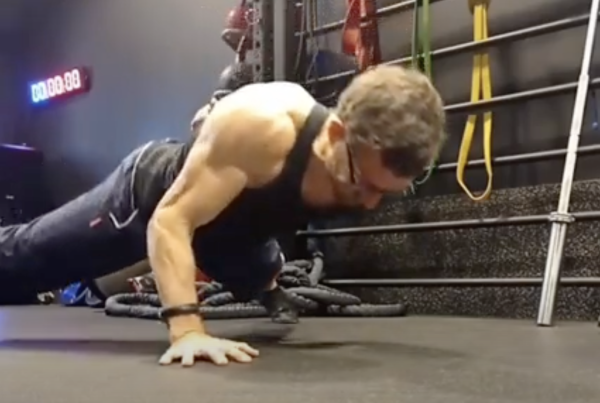With professional male athletes using mind/body practices to complement their sports performance, ‘men doing yoga’ is a growing fitness trend, as Aislinn Kelly discovers.
The Vedas, the original Sanskrit texts that first recorded the practice of yoga, can be traced back 5,000 years. Every reference to ancient yoga practitioners assumes a male identity, so it’s ironic that, today, yoga is seen more as a female pursuit than a practice that appeals to men. The irony is not lost on Matt Miller, founder of Broga (broga.uk.com), a yoga practice engineered to suit men.
“What people forget is that yoga was primarily practised by men,” he says. “However, in the last 10 years, women such as Gwyneth Paltrow and Madonna have attributed their bodies to yoga, so it’s been popularised in the West. Now, with professional male athletes practising yoga, there’s been a real shift and ‘men doing yoga’ is a buzz phrase.”
When Miller, a former American footballer, founded Broga, he had a lot of stereotypes to break down. “Men are competitive,” he tells me. “They don’t want to aspire to the stereotypical image of a guy with a pony tail and bead bracelet. I had to repackage yoga for the average, athletic man, while making sure it’s authentic to the core values of yoga. I used imagery and marketing that was as far from the stereotypes as you can get, referencing action figures – the childhood icons of masculinity.”
One of the reasons Miller believes yoga is becoming more popular with men is the rise of functional fitness. “There’s been a massive shift in the fitness world towards functional, whole-body fitness. You don’t need 50 pieces of equipment. In yoga, you use your body and connect with your muscles functionally. It’s the right timing – yoga meets with the functional way people want to approach fitness.” The number of male yoga teachers is gradually increasing in the UK too; at Yogahaven Clapham, more men are beginning to attend the teacher training courses, and seven out of the 26 Yogahaven Clapham instructors are men.
YogaAt founder James Muthana (yogaat.com) agrees that the male perception of yoga in the UK is changing. “A greater percentage of men are comfortable with yoga today – they get it,” he says. “Around a half to two-thirds of men we see understand the physical and mental benefits. The other third initially think yoga is for women – but then they do a class and realise it’s a lot harder than they expected.”
Appealing to men
“Yoga is the science of self-fulfilment and was originally used by male yogis to explore the questions of ‘who am I?’, ‘where do I come from?’, and ‘where do I go after this life?’” explains Conrad Paul, co-author of The Complete Guide to Yoga for Fitness Professionals. “In the health club environment, however, men want a more dynamic, more physically demanding style of yoga. Instructors won’t always teach the philosophy side because their job is to provide a good physical class.”
There are so many different yoga-based classes on offer that Paul believes there’s something to suit every man. “Once they’ve got to grips with the physical side, they can try different styles of yoga. In more fitness-based classes, the instructor may throw in some chanting and the guys will go with it – they still come back.” When it came to choreographing his Broga classes, Miller chose to break down the moves and build them back up again to be more progressive. He also changed the language to be more anatomical rather than spiritual. He explains, “Instead of saying ‘raise your heart’, which has spiritual connotations and requires an understanding of the philosophy behind it to truly understand it, I will say ‘put your hands behind your back, lace your fingers, lift your chest up and pull your shoulders back – and now you are lifting your heart’. I had to make it believable to an athletically minded male.”
In contrast, as a teacher trainer, Paul encourages his students to include some philosophy in their classes to maintain the aim of quietening the mind. Those who practice yoga are usually aware of its heritage and Paul believes most men are interested to experience the philosophical side – as long as they’ve got to grips with the physical elements first. “I wouldn’t dumb down the practice for men as they actually enjoy hearing the other elements,” he says. “At the start, a man may come to you simply because he has a bad hip but, six months later when he’s still there, you can start to layer in some of the philosophical side.”
Sophie Bickerdike, founder of Go Yoga in Harrogate (goyogaharrogate.com), agrees that male rehab is a burgeoning market. She welcomes several men who have had hip replacements or other injuries, preferring to give them one-to-one attention and tailor sessions to suit their particular ailment, taking them through gentle stretching sessions in a Hatha style. “It’s relaxing and restorative,” she says. “We get a lot of doctors and surgeons who have referred themselves.”
Sporting chance
At the Go Yoga studio is a climbing wall, and male climbers also join the sports yoga class to warm up before their three-hour climbing sessions. Bickerdike thinks of her sports yoga class as a men-specific session, although she doesn’t market it as such, and women do attend the class. “I’ve simply tailored the class to suit men, focusing on stretches, anatomy and posture, rather than the philosophy. If they ask about the philosophy, we’ll chat about it then. The difference is that, in the hot yoga class, which contains mainly women, there is loud music, incense, candles and chanting – we have none of that in the men-specific one. I’ve found that men like to get to the point.” With hot yoga still fairly new in the north of England, it’s yet to catch on with men, with just five men in a class of 28 at Go Yoga’s hot yoga sessions. In contrast, Yogahaven Clapham in London has seen an increase in men attending hot yoga in the last six months. Yogahaven trainee teacher Tessa Mabbitt says, “In our hot yoga classes between 30% and 40% of our participants are men. They like it because it’s dynamic and our mission is to get more men into hot yoga.”
YogaAt organises yoga and meditation for a large spectrum of clients, including the West Ham football team, which uses gentle Hatha yoga and flowing poses as a warm-down after training sessions, as founder Muthana explains, “We get the players to hold the poses for a long period of time to work on their hamstrings, etc. We would possibly add in a bit of meditation to help the players relax further, but we wouldn’t call it meditation. Doing meditation is a step too far for the professional footballers at the moment.” Many of YogaAt’s male clients participate in cycling, triathlons and running, and use yoga with the aim of avoiding injury. “They might train four or five times a week in their sport and also do two or three yoga sessions to work on their hamstrings, hip mobility and flexibility,” Muthana adds. “They use yoga as a warm-down session to complement their other training, improve their performance and minimise the risk of injury.”
Preparing for battle
While yoga provides an effective warm-down, a new mind/body practice called meypayatu (meypayatu.com) offers a mind-focusing warm-up, which could be performed before a sporting event or even an important meeting. Based on the principal movements of Kalaripayattu, a 3,000-year-old martial art form from Kerala, India, meypayatu is the root of all martial arts, from kung-fu to karate, and was originally practised by warriors before they went into battle. Creator and founder of meypayatu Gerry Elias explains that, while meypayatu shares similarities with yoga, it provides a more rigorous mind/body workout, which appeals to the male market.
“I looked at the intersection where mind/body meets cardio, dance and combat, and could find nothing that encompasses all four disciplines to help men develop strong, lean physiques,” says Elias. “Our own desktop research, where we found the issue referenced across various media1 including Men’s Journal and Men’s Health, has shown that men increasingly aspire to a leaner, more natural body shape, like that of a swimmer. Meypayatu helps to create this body shape through lengthening and filling out muscles.”
Unlike yoga, which culminates in a state of relaxation, meypayatu builds up into a series of high-intensity exercises to achieve a higher level of awareness and reach manasakti, which is one-pointed focus and complete doubtlessness. The practice ends by sustaining that heightened inner and outer awareness. “As meypayatu has a martial arts heritage and was used by warriors to achieve a single point of focus before battle, it destigmatises the assumed femininity around it as a mind/body practice, which makes it appeal to the male market,” explains Elias. “Meypayatu is a HIIT workout that builds strength, flexibility, cardio fitness, mind focus and stress management. You sweat really hard and there are kicks, strikes and blocks in the transition steps, which reference the martial arts, but there are also spiritual references too, such as touching the ground in devotion to the deity.”
Dynamic forms of yoga
Back at YogaAt, Muthana believes the fitness element is what attracts men to yoga. “Men like to do Ashtanga or power yoga – the fast-flowing disciplines that elevate the heart rate to 130-140bpm and make them sweat a lot,” he says. “In a hot room, the heart rate can go up even more. This form of yoga is a real cardio workout, promoting lean muscle and working on the core, which men appreciate.”
Conrad Paul, who teaches a form of freestyle Ashtanga called Dynamic Flow, agrees that men tend to lean towards the more dynamic forms of yoga, such as Dynamic Hatha and Dynamic Vinyasa. In classes that are predominantly male, he’ll teach more of the strong postures, such as the crow or headstand, as “men want to have a go at everything and they like the sense of achievement”. In time, Paul finds that men who originally wanted a more dynamic form of yoga are open to trying the gentler forms. “If you catch a guy on a day where he has done a hard training session for sport and he needs to stretch, this is the ideal time to introduce him to a gentler form of yoga,” he says.
A competitive spirit
Many of YogaAt’s male clients are city workers, who will often book private classes at home. In fact, the majority of YogaAt’s private home-based clients are male. “One reason for this,” says Muthana, “is these men are very driven and competitive. They don’t want to go to a class where they may not be the best. Guys can get frustrated when they can’t achieve the same flexibility as women, even if they have good cardio fitness and muscle definition.”
For Miller, the fact that yoga has taken so long to enter the sports arena is frustrating. “I wish I had been practising yoga when I was a professional sportsman,” he concludes. “I had no idea how much I really needed it.”
Alternative yoga practices
If power yoga, hot yoga or Hatha yoga don’t quite do it for you, why not check out some of the more, ahem, interesting styles on offer? While we can’t personally recommend them, some of them did give us a good giggle.
Yoga in the buff
So, naked yoga. It may be one step too far for the FitPro team but it claims to remove social and economic barriers, and deepen body acceptance, plus there’s the freedom of moving the body without the restriction of clothing.
Tantrum yoga
Tantrum yoga combines traditional yoga poses, dancing, shouting, chest-pounding and laughing. It’s designed to relieve frustration and release festering emotions.
Doga
Doga brings you and your four-legged friend together in a meditation, massage and stretching session for both human and dog.
Harmonica yoga
This musical form of yoga involves harmonica playing while practising yoga to help control breathing and develop mindfulness.
Voga
Voga is a mixture of yoga and voguing. Voguing is a highly stylised form of dance that featured in Madonna’s video for Vogue back in the 80s. Mix in some yoga poses and what have you got? Voga. Add fluorescent leg warmers and a skin-tight leotard for added authenticity.
Horseback yoga
Horseback yoga helps people connect with their horses through calming their mind, conscious breathing, heightening awareness, and gently opening tight spaces in the body. The aim is to enhance the communication between human and horse through conscious awareness and involves riders doing yoga on horseback, as well as beside their horses.
Karaoke yoga
Song lyrics flash across a large TV screen in this class as participants sing along to pop music while performing the moves, with a focus on feeling joyful rather than perfecting the poses.
Yoga raves
Yoga raves are designed to promote drug-free fun and combine movement, music and meditation in one class to release energy and relieve tension.
Pole yoga
Pole yoga, also known as polga, brings the pole and yoga together for an intense workout to improve flexibility, strengthening and stability.
Surfset
Surfset classes involve performing yoga moves on specially adapted surfboards that simulate the movement of a surfboard on the sea.
References
- The new physical ideal, http://edition.cnn.com/2012/03/23/living/male-ideal-body-image/index.html, accessed on 15 April 2015.







